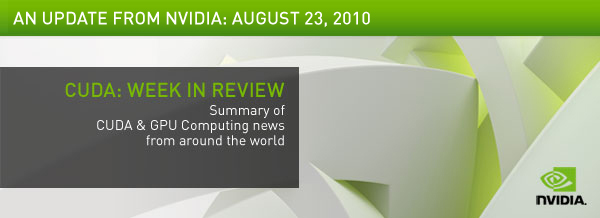
| Monday, August 23, 2010, Issue #33 - Newsletter Home |
| WELCOME | ||||||||||||||
Welcome to "CUDA: Week in Review," an online news summary for the worldwide CUDA and GPU Computing community.
| ||||||||||||||
| GPU TECHNOLOGY CONFERENCE COUNTDOWN: 27 DAYS! | ||||||||||||||
| GTC 2010 Update | ||||||||||||||
| We have an incredible line-up of technical content for the GPU Technology Conference (GTC 2010), covering many dimensions of the GPU ecosystem. Here's a sampling of newly-confirmed sessions:
– GPU-Enabled Biomedical Imaging Homer Pien, Mass General Hospital and Harvard Medical School – TSUBAME 2.0 Satoshi Matsuoka, Tokyo Institute of Technology – Domain Specific Languages Hanspeter Pfister, Harvard University – Evolution of GPUs for General Purpose Computing Ian Buck, Software Director, GPU Computing, NVIDIA For more info, check out our recent GTC blog post. We look forward to seeing you in San Jose! | ||||||||||||||
| CUDA SPOTLIGHT | ||||||||||||||
| Our World: 2.1 Billion Years Ago | ||||||||||||||
| An international team has discovered multi-cellular organisms in Gabon, Africa that are 2.1 billion years old -- with assistance from the GPU. This discovery was recently highlighted in Nature. To learn more, we contacted Arnaud Mazurier of ERM in Poitiers, France and Francois Curnier, CEO of Digisens. | ||||||||||||||
For info on Digisens, see: www.digisens.fr. For info on ERM, see: http://www.erm-poitiers.fr. | ||||||||||||||
| CUDA NEWS | ||||||||||||||
| Georgia Institute of Technology Named CUDA Center of Excellence | ||||||||||||||
| Georgia Institute of Technology (Georgia Tech) has been named a CUDA Center of Excellence. Jeffrey Vetter of Georgia Tech and Oak Ridge National Laboratory will serve as principal investigator. Prof. Vetter commented: "Georgia Tech has a long history of education and research that depends heavily on the parallel processing capabilities that NVIDIA has introduced with its CUDA architecture." See: http://research.nvidia.com/content/cuda-centers-excellence | ||||||||||||||
| CUDA APPS | ||||||||||||||
| CUDA Survey | ||||||||||||||
| CUDA Users: Please take a few minutes to tell us how you are using CUDA-capable GPUs and how we can better meet your needs. – https://surveys.nvidia.com/index.jsp?pi=a31edabdb979dd51982f46ac68c6bbc6 | ||||||||||||||
| MATLAB Benchmarks | ||||||||||||||
| John Melonakos of Accelereyes recently posted a blog entry comparing Tesla C2050 versus Tesla C1060 on MATLAB apps. He writes: "Double-precision examples on the Fermi-based board outperformed the older board by 50% in every case and better than 2X in many cases." – http://blog.accelereyes.com/blog/2010/08/03/tesla_c2050_versus_c1060_matlab_jacket/ | ||||||||||||||
| CUDA TRAINING | ||||||||||||||
| Post-GTC Workshop from SagivTech | ||||||||||||||
| SagivTech will hold a one-day workshop on Friday, September 24 at NVIDIA (following GTC) with a focus on CUDA optimization. Discount for GTC attendees. See: http://www.sagivtech.com/36923.html | ||||||||||||||
| New Parallel Nsight Webinars | ||||||||||||||
| ||||||||||||||
| GPU Computing Webinars from NVIDIA | ||||||||||||||
| – For info on all upcoming webinars, see: www.nvidia.com/webinars | ||||||||||||||
| Training from SagivTech | ||||||||||||||
|
– CUDA course: Sept. 27-29, San Francisco (following GTC 2010): http://www.sagivtech.com/36923.html – GPU Computing@30,000 feet: http://www.sagivtech.com/24054.html |
||||||||||||||
| Training from Acceleware | ||||||||||||||
| – Sept. 13-17, Calgary: www.acceleware.com/sep13calgary | ||||||||||||||
| Training from EMPhotonics | ||||||||||||||
| – On-site standard and customized training programs: http://www.emphotonics.com/services/cuda-training |
||||||||||||||
| CUDA Certification | ||||||||||||||
| – New certification program for GPU computing developers: www.nvidia.com/certification | ||||||||||||||
| CUDA and Academia | ||||||||||||||
| – Over 350 universities are teaching CUDA and GPU Computing courses around the world. – The CUDA Center of Excellence Program recognizes universities expanding the frontier of parallel computing. – The CUDA Research Center Program recognizes institutions performing leading-edge research. – The CUDA Teaching Center Program recognizes universities providing education and hands-on instruction. – The Academic Partnership Program provides support to researchers using GPUs to solve the world´s most challenging problems. – Learn more about NVIDIA´s Research and University activities at http://research.nvidia.com/ |
||||||||||||||
| CUDA DOWNLOADS | ||||||||||||||
| – Download CUDA 3.1 Toolkit: http://bit.ly/aKCENp – OpenCL v1.1 pre-release drivers and SDK code samples are available to GPU Computing registered developers. Log in or apply for an account to download. |
||||||||||||||
| CUDA CALENDAR | ||||||||||||||
|
August 2010 – Symposium on Chemical Computations on GPGPUs
– Unconventional High Performance Computing 2010 (UCHPC 2010)
September 2010 – GPU Technology Conference (GTC) 2010
– MATLAB Conference 2010
Future – Supercomputing 2010
– IEEE International Parallel & Distributed Processing Symposium
(To list an event, email: cuda_week_in_review@nvidia.com) |
||||||||||||||
| CUDA RESOURCES | ||||||||||||||
| CUDA Articles in Dr. Dobb's | ||||||||||||||
|
– Supercomputing for the Masses, Part 19: http://is.gd/dTIXj – Supercomputing for the Masses, Part 18: http://is.gd/cs6b9 – Supercomputing for the Masses, Part 17: http://is.gd/cs6eI – Supercomputing for the Masses, Part 16: http://is.gd/citaC |
||||||||||||||
| CUDA Books | ||||||||||||||
| – CUDA By Example by J. Sanders, E. Kandrot: http://is.gd/eo4pF – Programming Massively Parallel Processors by D. Kirk, W. Hwu: http://is.gd/7bNYP – See additional books here: http://www.nvidia.com/object/cuda_books.html |
||||||||||||||
| CUDA Documentation | ||||||||||||||
| – Download developer guides and documentation: http://developer.nvidia.com/object/gpucomputing.html |
||||||||||||||
| CUDA ON THE WEB | ||||||||||||||
|
– Read previous issues of CUDA: Week in Review: http://is.gd/cBXbg – Follow CUDA & GPU Computing on Twitter: www.twitter.com/gpucomputing – Network with other developers: www.gpucomputing.net – Stayed tuned to GPGPU news and events: www.gpgpu.org – Learn more about CUDA on CUDA Zone: www.nvidia.com/cuda – Read Kudos for CUDA: http://www.hpcwire.com/features/Kudos-for-CUDA-97889444.html |
||||||||||||||
| About CUDA | ||||||||||||||
|
CUDA is NVIDIA’s parallel computing hardware architecture. NVIDIA provides a complete toolkit for programming on the CUDA architecture, supporting standard computing languages such as C, C++ and Fortran as well as APIs such as OpenCL and DirectCompute. Send comments and suggestions to: cuda_week_in_review@nvidia.com | ||||||||||||||
Click here to opt in specifically to CUDA: Week in Review. | ||||||||||||||